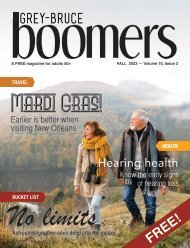Grey-Bruce Boomers Summer2023
You also want an ePaper? Increase the reach of your titles
YUMPU automatically turns print PDFs into web optimized ePapers that Google loves.
A FREE magazine for adults 50+<br />
SUMMER 2023 — Volume 10, Issue 2<br />
HISTORY<br />
Let’s<br />
dance<br />
<strong>Bruce</strong> County dance halls<br />
entertained for decades<br />
HEALTH AND WELLNESS<br />
Home takeover<br />
Unwelcome house guests<br />
a rising issue in our region<br />
BUCKET LIST<br />
Reach<br />
for the top<br />
Climbing Scotland’s<br />
‘Three Sisters’<br />
FREE!
We help to maintain<br />
independence and<br />
enhance quality of life.<br />
TRANSPORTATION<br />
OVERNIGHT<br />
RESPITE<br />
HOUSEKEEPING<br />
HOT & FROZEN<br />
MEALS ON WHEELS<br />
FRIENDLY<br />
VISITING<br />
DAY AWAY<br />
HCSSGREYBRUCE.COM | 1-800-267-3798<br />
RECEIVE SUPPORT VOLUNTEER DONATE<br />
June through August<br />
Kindness<br />
makes cents<br />
IN SUPPORT OF<br />
GREY-BRUCE<br />
Kindness<br />
This summer your<br />
will<br />
help to support independence and<br />
enhance quality of life for <strong>Grey</strong> & <strong>Bruce</strong><br />
residents and their families.<br />
Learn More & Join Us!<br />
HCSSGREYBRUCE.COM
FROM THE PUBLISHER<br />
Did you know this past winter in Ontario was the darkest in 80 years? The<br />
grey skies seemed to be never-ending, and I can’t specifically recall a day in<br />
the depths of winter when the sun was shining.<br />
Despite the fact we haven’t jumped right from winter to summer – April<br />
threw a true spring at us with a mixed bag of temperatures – I think everyone<br />
in <strong>Grey</strong>/<strong>Bruce</strong> will be hoping for a long, hot summer. Having received some<br />
beautiful days early in April and into May, I think we may be on track to<br />
replenish our Vitamin D stores this summer.<br />
We have another fantastic issue planned, this issue being the 9th summer<br />
issue we’ve published since launching in December 2014! Doug Archer<br />
writes in our Bucket List feature about local hikers Ian and Terry Kennedy,<br />
who conquered Scotland’s Three Sisters. <strong>Grey</strong> <strong>Bruce</strong> Public Health shares<br />
important information about the growing concern around home takeovers,<br />
and how to protect your loved ones from unwanted house guests who<br />
eventually assume the head of household. Robin Hilborn brings us a blast<br />
from the past with the history of dance pavilions along the Lake Huron<br />
shoreline. Yoga teacher Esperanza Eusebio has some gentle and loving tips<br />
about learning to “let go,” and finally, local history expert Mat Johnson<br />
writes about Eugenia Falls and its interesting past.<br />
We all know summer seems to go by more quickly each year, with gettogethers<br />
with family, barbecues, summer recreational activities and the<br />
regular everyday tasks we do to keep a household<br />
running. It’s a challenge to sit back and soak it all<br />
in, but my hope for you this summer is that you<br />
find the time to slow down and enjoy it – Old<br />
Man Winter will return soon enough.<br />
Amy Irwin, Publisher<br />
<strong>Grey</strong>-<strong>Bruce</strong> <strong>Boomers</strong><br />
CONTENTS<br />
Bucket List • 4<br />
Home takeovers • 10<br />
Dance pavilions • 16<br />
Art of letting go • 22<br />
Eugenia Falls • 26<br />
Recipe • 30<br />
SUMMER 2023<br />
Publisher<br />
Amy Irwin<br />
amy@greybruceboomers.com<br />
Magazine Design<br />
Becky Grebenjak<br />
Advertising inquiries<br />
amy@greybruceboomers.com<br />
<strong>Grey</strong>-<strong>Bruce</strong> <strong>Boomers</strong> welcomes<br />
your feedback.<br />
EMAIL<br />
amy@greybruceboomers.com<br />
PHONE 519-524-0101<br />
MAIL<br />
P.O. Box 287, Ripley, ON N0G 2R0<br />
<strong>Grey</strong>-<strong>Bruce</strong> <strong>Boomers</strong> is distributed for free in <strong>Grey</strong> and <strong>Bruce</strong><br />
counties, and is published each March, June, September, and<br />
December. Distribution of this publication does not constitute<br />
endorsement of information, products or services by <strong>Grey</strong>-<strong>Bruce</strong><br />
<strong>Boomers</strong>, its writers or advertisers. Viewpoints of contributors and<br />
advertisers are not necessarily those of the Publisher. <strong>Grey</strong>-<strong>Bruce</strong><br />
<strong>Boomers</strong> reserves the right to edit, reject or comment on all material<br />
and advertising contributed. No portion of <strong>Grey</strong>-<strong>Bruce</strong> <strong>Boomers</strong> may<br />
be reproduced without the written permission of the Publisher.
THE BUCKET LIST<br />
Reach<br />
for the top<br />
IAN AND TERRY KENNEDY CLIMB SCOTLAND’S ‘THREE SISTERS’<br />
BY DOUG ARCHER<br />
4 • GREYBRUCEBOOMERS.COM
y Doug Archer<br />
THE BUCKET LIST<br />
As they came around the base of the mountain,<br />
Ian and Terry Kennedy stopped dead in their<br />
tracks. They gazed up, mouths hanging open. Before<br />
them, looming against the grey Scottish sky, were<br />
the infamous peaks of Glencoe, Scotland: Aonach<br />
Dubh, Beinn Fhada and Gearr Aonach.<br />
A trio of towering sandstone ridges more commonly<br />
known as The Three Sisters.<br />
“Terry said all the colour drained from my face<br />
at the sight of the Sisters,” Ian said. “It was very<br />
daunting. I felt like they were glaring down at us,<br />
just daring us to try to scale them. Not only were<br />
the peaks extremely high, but they were extremely<br />
narrow, too. I remember thinking, ‘What have we<br />
gotten ourselves into?’”<br />
Ian’s love of mountain hiking and climbing started<br />
when he was just a wee lad growing up in Scotland.<br />
“My grandfather would rent a ‘But and Ben’ – that’s<br />
Scottish for a two-room cottage – in a place called<br />
Glenisla, and my family would go there for two weeks<br />
every summer,” he explained. “It was definitely off<br />
the beaten path. No power or running water. We had<br />
to park the car along the road and hike to it, carrying<br />
everything we needed on our backs. But I have really<br />
fond memories of that wonderful place.”<br />
Ian and his brother would spend their days exploring<br />
the surrounding hills and sheep trails. A fishing fanatic,<br />
he found the quickest way to get to a fishing spot in<br />
Glenisla was usually up and over a hill or mountain.<br />
“So that But and Ben was where my passion for<br />
hiking was born.”<br />
Terry came to mountain trekking a little later in life<br />
– largely because of Ian.<br />
“One of the first dates he took me on was to Lake<br />
Placid, so we could hike the Adirondack Mountains,”<br />
Terry and Ian Kennedy conquered<br />
Scotland’s Three Sisters.<br />
she laughed. “But it became an addiction. Once I<br />
started, I couldn’t get enough of it. Being out in the<br />
open air, surrounded by nature, pushing yourself,<br />
testing your limits. It’s a wondrous feeling.”<br />
The couple can’t get enough of that wondrous<br />
feeling, either.<br />
SUMMER 2023 • 5
THE BUCKET LIST<br />
by Doug Archer<br />
They have hiked hills and mountains in Canada<br />
and the U.S. and tramped along coastal paths in<br />
England and Australia. They’ve climbed glaciers<br />
and volcanoes in New Zealand and were even<br />
rescued by helicopter three days into a hike at that<br />
country’s Milford Sound, when torrential rains<br />
made the trails impassable.<br />
Still, their favourite place to hike is where it all began<br />
for Ian, in Scotland.<br />
The two have journeyed from one end of the<br />
country to the other, scaling the backsides of Munros<br />
and Corbetts, Grahams and Donalds – and those<br />
aren’t Highland clans, that’s what the Scottish call<br />
their mountains. Munros are those over 3,000 feet,<br />
Donalds are in the 2,000-foot range, and Corbetts<br />
and Grahams are in between. Yet, until the autumn<br />
of 2022, Ian and Terry had never climbed the<br />
infamous Munros known as the Three Sisters.<br />
Located in a group of mountains south of Glencoe,<br />
the Sisters are three, steep-sided towers that rise<br />
majestically from a lush valley into the heavens, like<br />
a picture straight out of a medieval storybook.<br />
“The first time we visited Glencoe, we stood at the<br />
end of the valley and saw the Three Sisters rising<br />
out of it,” recalled Ian. “It was one of the most<br />
magnificent views I have ever set my eyes upon.”<br />
Since that day, both Ian and Terry have wanted to<br />
hike those iconic formations, but they kept talking<br />
themselves out of it, until finally taking the leap this<br />
past September.<br />
“The sheer height and steepness of the ridges is<br />
unnerving and that’s probably what made us keep<br />
putting it off,” Terry said. “We were heading back<br />
to Scotland for a 60th birthday celebration for Ian’s<br />
brother and decided it was time to scale them.”<br />
They arrived in Scotland two weeks before the climb
y Doug Archer<br />
THE BUCKET LIST<br />
and promptly talked the family into doing some pretraining<br />
with them.<br />
“We hiked as a group up Mount Blair, which is a<br />
wee Graham,” Ian said. “It was in memory of my<br />
parents, whose ashes lie at the top.”<br />
A few days later, the couple climbed another Graham<br />
with their son Andrew, before finally tackling some<br />
Munros on our own.<br />
“We even climbed 3,554 feet to the peak of a<br />
mountain called Schiehallion,” Ian said, “The point<br />
from which the mass of the earth was determined<br />
back in 1774.”<br />
All this was just a warm-up for the main event, though,<br />
which they couldn’t put off any longer. Minutes after<br />
sunrise on Sept. 24, 2022, Ian and Terry found<br />
themselves staring up at the Three Sisters. Their<br />
backpacks were loaded with compasses and a first aid<br />
kit, matches and flashlights, sandwiches, nuts, dried<br />
fruit, and an abundance of water. Family members<br />
had been given details of their departure time and<br />
expected time of return. They had topographical<br />
maps of the peaks. Their walking poles were in<br />
hand. All that was left was to start the climb.<br />
The terrain up the Three Sisters is known to be<br />
steep, complex and very rocky. According to Ian, it<br />
was all that and more.<br />
“The climb to the first peak is along a very narrow<br />
path, only about a foot-and-a-half wide, with sheer<br />
drops on either side,” he said. “Terry led the way,<br />
and as we approached the summit, I got more and<br />
more nervous and convinced myself that I would<br />
have to go around it. That’s when we realized there<br />
Escape Your Routine<br />
OUTDOOR SPA EXPERIENCE<br />
Reserve online | Relax in Nature<br />
SCANDINAVE.COM<br />
SUMMER 2023 • 7
THE BUCKET LIST<br />
by Doug Archer<br />
The temperature was -3 C on top of the ridges, but<br />
the climb was so intense and nerve-wracking that<br />
Terry and Ian had to keep stripping layers off as they<br />
went. All the while, they provided support to one<br />
another.<br />
“We have a good read of each other,” Terry said.<br />
“When we saw that one was slowing down or becoming<br />
apprehensive, we would offer encouragement,<br />
basically cheering one another on. At particularly<br />
difficult spots on the climb, we stopped and together<br />
figured out the best way to proceed.”<br />
That was a good thing because the descent from the<br />
third peak proved to be particularly difficult. You<br />
see, after reaching the summit of that final peak,<br />
the Kennedys couldn’t find the path that would take<br />
them back down.<br />
Ian Kennedy in an ice crevasse on<br />
a previous glacier hike.<br />
was no way around. It was either turn back or go up<br />
and over. And there was no way I was turning back.”<br />
Terry had to talk him through the ascent, step-bystep,<br />
coaxing him along, reminding him not to look<br />
down. Once on the summit, Ian got Terry to take<br />
a quick photo of him – to prove that he’d actually<br />
made it to the top – before inching his way back<br />
down and onto the next peak.<br />
Unfortunately, the second was no easier to scale than<br />
the first.<br />
“It was just as high and no less treacherous,”<br />
explained Ian. “And again, you couldn’t turn back!<br />
It was too jagged and steep. So forward was the only<br />
direction.”<br />
“We were at the area that our map showed as the<br />
point of descent, but we couldn’t see a way down<br />
that was passable,” Ian recounted. “The narrow path<br />
was all crumbling, loose rock, with sheer 1,000-foot<br />
drops on either side! I told myself that this couldn’t<br />
possibly be the way down.”<br />
It turned out it was.<br />
The couple learned later that there had been<br />
significant erosion to the path the previous week, due<br />
to heavy rainfall. Now, because of that erosion, they<br />
found themselves faced with only two options – hike<br />
six hours back the way they’d come, or, as Terry put<br />
it, “Take some deeps breaths and head down.”<br />
While the pair hesitated, another four hikers arrived.<br />
According to Ian, they looked even more terror<br />
stricken than he and Terry when they saw the state<br />
of the path. So, Ian suggested they all go down<br />
together, as a group, in case anything went wrong.<br />
Everyone readily agreed.<br />
“We descended in a ‘figure Z’ configuration, staying<br />
8 • GREYBRUCEBOOMERS.COM
y Doug Archer<br />
THE BUCKET LIST<br />
close together,” Ian said. “There was so much loose<br />
rock that we had to move really slowly, testing almost<br />
every step we took. And we had to hold onto each<br />
other through difficult sections, because if you<br />
slipped and fell… well, you were going to drop over<br />
1,000 feet!”<br />
No one did, thankfully and once back on solid, flat<br />
ground, the Kennedys breathed a sigh of relief and<br />
elation. They had scaled the iconic Three Sisters of<br />
Glencoe!<br />
“The sense of accomplishment was amazing,” said<br />
Ian. “Afterward, sitting on the patio of a tavern<br />
overlooking the three ridges, we basked in the feeling<br />
of knowing that we had been up there, higher than<br />
the clouds, hiking through the most celebrated<br />
Munros of the Scottish Highlands.”<br />
Of course, the couple has plans for future treks. The<br />
Appalachian Trail is on their Bucket List, as well as<br />
the 800 km Camino pilgrimage in Spain. In honour<br />
of Terry’s Dutch heritage, they are also planning to<br />
walk 40 km per day for four days in what is called the<br />
Nijmegen March. Held each year in the Netherlands,<br />
it is the largest multiple-day marching event in the<br />
world.<br />
“We still have a lot more hikes left in us,” Ian laughed.<br />
Doug Archer is a freelance writer and speaker who enjoys<br />
celebrating the multi-faceted lives of the 50-plus generation. He<br />
is also the author of three locally set mystery-adventure novels.<br />
Learn more at www.coldcasekids.com or archer@bmts.com.<br />
SUMMER 2023 • 9
HEALTH AND WELLNESS<br />
When home isn’t safe<br />
PUBLIC HEALTH RAISING AWARENESS OF<br />
‘HOME TAKEOVERS’ BY LISA ALGUIRE
y Lisa Alguire<br />
They say, your home should be your sanctuary<br />
– it’s the one place where you should feel safe,<br />
secure, and protected.<br />
However, for people experiencing a “home takeover,”<br />
this isn’t the case because this person’s sanctuary has<br />
become a place where the resident feels in danger,<br />
scared, or threatened.<br />
For more than a year, <strong>Grey</strong> <strong>Bruce</strong> Public Health has<br />
been working with <strong>Grey</strong> County and other community<br />
partners to examine and develop strategies to<br />
address the emerging issue of home takeovers in<br />
the area. This multi-sectoral collaboration set out<br />
to investigate the prevalence of home takeovers<br />
locally, understand the current response to home<br />
takeovers and gaps in that response, raise awareness<br />
of the issue, and create a framework to help guide<br />
community partners’ responses to home takeovers.<br />
What is a home takeover?<br />
To fully understand the issue of home takeovers,<br />
it’s important to start with the basics, based on this<br />
simple definition: A home takeover occurs when<br />
a vulnerable homeowner or tenant is forced to<br />
accommodate an unwanted guest in their home.<br />
Building upon that definition, the unwanted guest<br />
– who may also be referred to as a perpetrator of<br />
the home takeover – could be a relative, friend, or<br />
HEALTH AND WELLNESS<br />
acquaintance of the home’s legitimate occupant.<br />
They may have initially been invited to stay over –<br />
often to fulfil a personal, social, or economic need<br />
of the occupant. For example, an older adult may<br />
allow someone to stay in their home to help with<br />
household expenses, such as rent or food. Perhaps,<br />
they allowed the person to stay over because they<br />
were lonely or feeling isolated. Other factors that<br />
might contribute to the occupant’s vulnerability to a<br />
home takeover include empathy for the perpetrator’s<br />
situation, a desire to help, or significant pressure to<br />
house the perpetrator.<br />
No matter what the initial reason may be, the invited<br />
guest eventually “takes over” the home.<br />
The situation becomes a home takeover when<br />
the perpetrator refuses to leave and their actions<br />
or activities make the occupant feel unsafe,<br />
uncomfortable, or threatened in their own home. In<br />
other words, the home no longer feels like a safe place.<br />
Impacts of a home takeover<br />
Threats, guilt, violence, manipulation, or financial<br />
exploitation are among the reasons the legitimate<br />
occupant of a home may accommodate the<br />
perpetrator of a home takeover.<br />
Consequences of a home takeover may include loss<br />
of control within the home or even eviction. As an<br />
This could be you…<br />
Experience the<br />
Freedom to Discover<br />
‘Travel Light with Prolite’<br />
1150 Wallace Ave. N., (Hwy 23) Listowel, ON<br />
1 (888) 453-9105 | www.LonghaulTrailerSales.com<br />
SUMMER 2023 • 11
HEALTH AND WELLNESS<br />
by Lisa Alguire<br />
example, if the perpetrator engages in illegal activity<br />
within the unit, the occupant could face eviction.<br />
This can be devastating to a vulnerable tenant,<br />
particularly if they lose their place in community<br />
housing.<br />
For children, the home and neighbourhood are<br />
fundamental for healthy growth and development,<br />
including mental health. Witnessing neighbourhood<br />
violence and victimization impacts children even<br />
when the home takeover is not happening in their<br />
own home.<br />
Many homeowners or tenants may find they are<br />
unable to avoid or escape the perpetrator due to<br />
a lack of supports or resources. It’s important to<br />
note that the perpetrator of a home takeover is, in<br />
most cases, also considered vulnerable and may be<br />
engaging in the home takeover to fulfill their own<br />
unmet need(s), such as a need for housing.<br />
Local collaboration<br />
In the fall of 2021, <strong>Grey</strong> County Housing began seeing<br />
home takeovers happening in community housing<br />
neighbourhoods. The tenants, families, or individuals<br />
taking over the unit(s) and the neighbourhood were<br />
negatively affected by home takeovers. To better<br />
understand the issue, <strong>Grey</strong> <strong>Bruce</strong> Public Health staff<br />
researched what was known about home takeovers.<br />
That research indicated perpetrators are most likely<br />
to target people who have vulnerabilities.<br />
Several community partners were invited to<br />
meet and discuss the research findings. They also<br />
participated in a survey to understand the current<br />
response and gaps in responding to a home takeover<br />
in <strong>Grey</strong> County. The survey found that half of the<br />
community partners surveyed had not heard of the<br />
term ‘home takeover,’ but nearly all had encountered<br />
dealing with it over the past year.<br />
A Home Takeover Advisory Committee was<br />
formed. It includes housing organizations, mental<br />
health and addiction services, police, fire, and other<br />
community organizations. As part of a pilot project,<br />
a comprehensive plan was developed with the<br />
goal of reducing the incidence of home takeovers.<br />
Several resources and materials were created to<br />
raise awareness of home takeovers within relevant<br />
organizations and the general public.<br />
A Home Takeover Response Framework and Pathway<br />
was developed as an approach to build community<br />
partners’ capacity to prevent, identify, respond to,<br />
and support recovery from home takeovers.<br />
Every home takeover situation is unique in its<br />
circumstances, and the complexities associated with<br />
home takeovers require good judgment from service<br />
providers in deciding on the most appropriate course<br />
of action. The Response Framework defines the<br />
roles of each community partner involved in a home<br />
takeover and outlines how we can respond using a<br />
more coordinated approach.<br />
Raising awareness<br />
To help raise awareness about home takeovers, the<br />
advisory committee has developed brochures, flyers,<br />
and other resources. One of the documents lays out<br />
questions that you can ask yourself to help determine<br />
if a family member, friend, or someone else you<br />
know is at risk of experiencing a home takeover.<br />
Examples of those questions include:<br />
• Have you seen a change in the person’s<br />
behaviour?<br />
• Are they more withdrawn or are they not showing<br />
up where you would normally see them?<br />
• Is the person telling you they’re always out of<br />
money or food?<br />
• Are they showing signs of weakness, weight loss,<br />
stress or abuse?<br />
• Has the person told you they have a guest?<br />
12 • GREYBRUCEBOOMERS.COM
y Lisa Alguire<br />
HEALTH AND WELLNESS<br />
• Have you noticed increased activity around the<br />
person’s home?<br />
• Is there more noise coming from the person’s<br />
unit than usual?<br />
• Are there people you don’t recognize around<br />
the person’s home or is the same guest always<br />
coming and going from the person’s home?<br />
For service providers in <strong>Grey</strong>-<strong>Bruce</strong>, the following may<br />
indicate a home takeover is occurring with the tenant:<br />
• The individual becomes reluctant to allow the<br />
worker into their home or requests that meetings<br />
occur outside the home.<br />
• The tenant has not checked in with the worker<br />
in some time and is noticeably absent from the<br />
home. Some home takeover targets turn up in<br />
shelters despite being legitimate tenants of a<br />
rented unit because they have been forced out or<br />
no longer feel comfortable in their own home.<br />
• Landlords or property managers may receive an<br />
increase in complaints about a unit, particularly<br />
concerning noise, excessive visitors, increases in<br />
cars or bikes outside, and the uncharacteristic<br />
presence of young people at the property.<br />
• There is a noticeable change in the tenant’s<br />
financial situation, including an uncharacteristic<br />
inability to pay rent, bills or buy groceries.<br />
• The tenant’s physical appearance has<br />
deteriorated.<br />
• There is an increase in reports that the individual<br />
has become more isolated from friends, family<br />
and/or social groups.<br />
• If given access to the home, contents within<br />
suggest that more individuals are staying in the<br />
unit than those that reside there, or in some<br />
cases, the takeover perpetrator(s) are there.<br />
Custom Hearing Aids, Repair & Maintenance, Custom Ear Plugs and More!<br />
Support<br />
Better Hearing<br />
and Speech<br />
Awareness!<br />
Your first steps to<br />
Better Hearing<br />
Earwax Removal<br />
Hearing Test<br />
Book An Appointment Today!<br />
HANOVER<br />
519.364.4327<br />
OWEN SOUND<br />
519.371.3290<br />
DURHAM<br />
519.369.3277<br />
SARNIA<br />
519.337.2679<br />
activears.com<br />
PREVENTION ASSESSMENT TREATMENT<br />
SUMMER 2023 • 13
HEALTH AND WELLNESS<br />
by Lisa Alguire<br />
A home takeover occurs when a<br />
vulnerable homeowner or tenant<br />
is forced to accommodate an<br />
unwanted guest in their home.<br />
Home takeover resources<br />
This year, the home takeover project will continue<br />
to focus on raising awareness about the issue<br />
in our communities, as well as gaining a better<br />
understanding of the prevalence of home takeovers<br />
and other social needs in the community through<br />
data collection. <strong>Grey</strong> <strong>Bruce</strong> Public Health is<br />
planning to hold events to help educate people about<br />
home takeovers. It will also be using its social media<br />
platforms to help spread awareness. Resources, like<br />
pamphlets and posters, will help spread the word<br />
about this emerging issue.<br />
The Home Takeover Advisory Committee has<br />
developed a 10-question checklist, entitled Welcomed<br />
Guest or Home Takeover? to help homeowners or<br />
tenants determine if they are experiencing (or at risk<br />
of experiencing) a home takeover. It is important to<br />
protect your home and reach out for support when<br />
needed.<br />
A guidebook for organizations and service providers,<br />
along with a presentation, has been created to<br />
assist organizations and service providers to<br />
offer opportunities for education and awareness<br />
concerning home takeovers for vulnerable tenants,<br />
frontline workers and the broader community. All<br />
of these resources are available on the <strong>Grey</strong> <strong>Bruce</strong><br />
Public Health website under the ‘Your Environment’<br />
drop-down menu and ‘Healthy Housing, Home<br />
Takeover.’<br />
Everyone should feel safe in their own home. Targets<br />
of a home takeover are encouraged to talk to<br />
someone they trust. That might be a support worker,<br />
landlord, family member, neighbour or friend. Not<br />
sure who to call? Call or text 211.<br />
Lisa Alguire is a Public Health Nurse at <strong>Grey</strong> <strong>Bruce</strong> Public<br />
Health and part of GBPH’s Foundational Standards<br />
team. She has been co-lead of the multi-sectoral Home<br />
Takeover Pilot Project since its inception. Learn more at<br />
www.publichealthgreybruce.on.ca.<br />
14 • GREYBRUCEBOOMERS.COM
Learn how we generate clean energy and produce<br />
medical isotopes at the <strong>Bruce</strong> Power Visitors’ Centre.<br />
Wonder.<br />
Explore.<br />
Discover.<br />
Starting in June<br />
Summer<br />
Bus Tours<br />
Register in advance<br />
on our website<br />
www.brucepower.com/visit<br />
3394 BRUCE ROAD 20, NORTH OF TIVERTON, WEST OF HIGHWAY 21. T: (519) 361-7777<br />
SUMMER 2023 • 15
HISTORY<br />
DANCE<br />
PAVILIONS<br />
POPULAR HALLS BEGAN OPENING ALONG THE LAKE HURON<br />
SHORELINE IN THE 1920S BY ROBIN HILBORN<br />
Dancing at Kincardine Pavilion.<br />
(<strong>Bruce</strong> County Museum & Cultural Centre, A2017.058.001)<br />
16 • GREYBRUCEBOOMERS.COM
y Robin Hilborn<br />
HISTORY<br />
Those were the days – summer breezes off Lake<br />
Huron, strolling the beach as swing music wafts<br />
from the hall, and dancing under the stars.<br />
Beachfront dance pavilions became common in<br />
Ontario’s lakeside resort towns beginning in the<br />
1920s, with seven on the <strong>Bruce</strong> County coastline.<br />
The oldest, at Oliphant, was joined by dance halls<br />
at Sauble Beach (two), Southampton, Port Elgin,<br />
Inverhuron and Kincardine.<br />
At Oliphant, William McKenzie built McKenzie’s<br />
Pavilion in 1921. The dance hall was on the second<br />
floor, above stalls for parking cars and storing boats.<br />
Since power lines did not reach Oliphant until 1949,<br />
the pavilion’s lights were powered by lead-acid batteries<br />
charged by a 32-volt Delco Light gasoline generator.<br />
During the 1930s and ’40s, the pavilion attracted<br />
dancers from up and down the shores of Lake Huron<br />
and Georgian Bay. William’s son Mac recalled his<br />
summer job, sprinkling powdered wax on the floor<br />
and taking tickets as couples entered the dance<br />
floor – admission to the dance hall was 10 cents per<br />
person, plus five cents for every “dance” (two musical<br />
numbers). As nearby Sauble Beach Pavilion grew<br />
more popular, the crowds abandoned Oliphant.<br />
Eventually the pavilion was used only for the annual<br />
Civic Holiday Regatta dance, then it became a flea<br />
market. In the 1980s, owner Susie Morris renamed<br />
the building the Oliphant Pavilion.<br />
Sauble Beach’s original dance hall was Bob<br />
Walker’s eight-sided Octagon, built on the beach<br />
in 1933. Wally Scott, band leader and accountant<br />
at Hepworth Furniture in Southampton, together<br />
with his brother-in law Jack Robertson, bought the<br />
Octagon and opened it in 1946 as the Sauble Beach<br />
It’s Time For A<br />
Fresh Approach On<br />
Retirement Living!<br />
www.owensoundgardens.com | 519.371.7037<br />
SUMMER 2023 • 17
HISTORY<br />
by Robin Hilborn<br />
In 1922, the Knowles family added a dance pavilion<br />
to its Breakers Lodge resort on Southampton beach.<br />
It headlined well-known big bands such as Guy<br />
Lombardo and His Royal Canadians and Ferde<br />
Mowry’s band from Toronto. Southampton resident<br />
Margaret Large remembered the summer nights of<br />
the 1920s.<br />
“The pavilion opened with the music of the<br />
Southampton Rayner Dance Band,” Margaret<br />
said. “I believe dances were five cents. The Rayners<br />
played ‘Valencia’ at least five times every night. My<br />
sister and I would sit on the porch listening to the<br />
music as we were too young to go to the dances.”<br />
At Sauble Beach, Wally Scott’s orchestra, 1947. (<strong>Bruce</strong><br />
County Museum & Cultural Centre, A2007.075.003)<br />
Pavilion. Later they added an outdoor terrazzo floor<br />
so couples could dance under the stars on warm<br />
summer evenings.<br />
The house band in those years was the Wally Scott<br />
Orchestra, while a regular visitor was the Warren<br />
Ovens Band from Kitchener. In 1950, Scott and<br />
Robertson replaced the old structure with a bigger<br />
dance hall on the same site, retaining the open-air<br />
portion. The new layout held up to 2,500 dancers.<br />
The Pavilion also hosted Bingo, movies and country<br />
dances with Don Robertson’s Ranch Boys. In the ’60s<br />
and ’70s, rock bands like Crowbar kept the Pavilion<br />
open, but crowds declined to the point that the owners<br />
retired in 1978 and demolished the building.<br />
Stewart Wilson thought there was room for a<br />
second dance pavilion at Sauble Beach and built the<br />
Danceiro dance hall in 1967. He brought in name<br />
rock bands like the Calgary Stampeders. Though<br />
Wilson also hired local bands to attract an audience<br />
for country music, Danceiro suffered from its location<br />
far from the beach and on the highway, a mile north<br />
of Sauble Falls. It closed in 1972 and the building<br />
became an auto body shop.<br />
The pavilion closed in 1942 and was renovated as<br />
guest rooms. The Breakers Lodge was closed in 1990<br />
and the 103-year-old hotel and annex was torn down.<br />
Opened in 1924 on Port Elgin beach, Cedar Crescent<br />
Casino offered dancing six nights a week. The Ferde<br />
Mowry band played the Casino in the 1930s and<br />
the band’s sax player Emmett McGrath fell in love<br />
with the hall. In 1944, he and his wife Pat bought it<br />
and made it one of the town’s major summertime<br />
attractions. Vacationers thronged to see bands led by<br />
the Wright Brothers, Ozzie Williams, Brian Farnon,<br />
Norm Harris and Bert Worth.<br />
From 1950-64, the house band was Lloyd Kibbler’s<br />
Big Band from Owen Sound. Moving with the<br />
times, the McGraths introduced Twist contests,<br />
Go-Go nights and rock music by stars like David<br />
Clayton Thomas, Ronnie Hawkins, Robbie Lane,<br />
Paupers, Major Hoople’s Boarding House and local<br />
band Gordon Rhodes and the Swingin’ Comets. In<br />
1968, the McGraths retired and sold the pavilion. It<br />
burned down two years later and Port Elgin lost its<br />
great beach attraction. A new pavilion at the same<br />
location lasted about 10 years – it was condemned as<br />
structurally unsafe and demolished. Big band music<br />
continued to live, however, with the founding of the<br />
annual Canadian Big Band Celebration in 1995.<br />
18 • GREYBRUCEBOOMERS.COM
y Robin Hilborn<br />
HISTORY<br />
Built in 1930, the dance hall at Inverhuron beach<br />
was originally called Casa Nova Gardens. Before<br />
the war, George Scott was bass player in the Tony<br />
Cryan band, based in Stratford. He wanted to run<br />
his own pavilion and bought the Gardens in 1948.<br />
He catered to the many farmers in the area – he<br />
hired local bands, which played for both round and<br />
square dancing. One of the best callers was Skipper<br />
McKinnon. As other forms of entertainment grew,<br />
like TV and bars, the dance business shrank. Scott<br />
closed the Inverhuron Pavilion in 1964 and turned it<br />
into apartments.<br />
The Kincardine Pavilion opened during the 1923<br />
Old Boys and Girls Reunion. As with all the beach<br />
pavilions, couples could stroll along the lakefront and<br />
enjoy the music floating into the evening air. In Lake<br />
Huron’s Summer Dance Pavilions, author Peter Young<br />
named some of the bands presented there: Giles<br />
Merrymakers, Don Messer, Lionel Thornton, Mart<br />
Kenney and the bands of John Brenan and Johnny<br />
Downs, both from London. Young wrote, “Paper<br />
dresses were available for rent if a young woman<br />
was wearing shorts at the beach during the day and<br />
wished to attend the dance at night.”<br />
The Kincardine Pavilion was due for demolition in<br />
2004 but volunteers from the Friends of the Pavilion<br />
group used grants and loans to restore the 1923 hall<br />
to its former glory, bringing back live Big Band music<br />
and dancing to Kincardine. Home to the Lighthouse<br />
Swing Band as well as a favourite spot for weddings<br />
with its home on Kincardine’s north beach, it’s the<br />
last surviving dance pavilion on the <strong>Bruce</strong> coast.<br />
Excerpted from ‘The <strong>Bruce</strong>,’ published by the <strong>Bruce</strong> County<br />
Historical Society.<br />
SUITES RENTING FAST<br />
move in now<br />
Welcome to Edgewood Suites, a vibrant adult living community<br />
in the heart of Dundalk, where you can experience the comfort<br />
of small town living, yet close to every modern amenity you<br />
may need. Choose from studios, 1 or 2 bedroom suites featuring<br />
private balconies, and a variety of building amenities.<br />
Starting from<br />
$<br />
1,594<br />
All Inclusive<br />
CONTACT US TO BOOK A TOUR!<br />
edgewoodsuites.ca<br />
(226) 274-5008<br />
info@edgewoodsuites.ca<br />
Prices and specifications subject to change without notice. E. & O. E.<br />
SUMMER 2023 • 19
A private collection of four-season modern towns, bungalows and singles.<br />
*Renderings are artist’s concept. E&OE.
UNDER THE MOUNTAIN,<br />
CLOSE TO THE SHORE.
OPINION<br />
The art of<br />
letting go<br />
REMOVING UNNECESSARY THOUGHTS AND ITEMS FROM YOUR<br />
LIFE CAN HAVE A POSITIVE IMPACT BY ESPERANZA EUSEBIO<br />
22 • GREYBRUCEBOOMERS.COM
y Esperanza Eusebio<br />
OPINION<br />
We are constantly on the move, and everywhere<br />
we look we’re being offered more things,<br />
different lifestyles, and miracle diets for achieving a<br />
new body and status.<br />
It is overwhelming to watch TV nowadays, or<br />
browse social media. It is almost impossible to quit<br />
wanting more since it is our nature as a human, but<br />
it is possible. My background is in marketing and<br />
business, so I have learned all the tools and techniques<br />
over my career to promote and sell things, but the<br />
question remains, do we need more?<br />
There is always the next best thing that we want<br />
to bring to our lives, but what we truly need is an<br />
awareness of how fortunate we are to live in today’s<br />
age. Consider how easy it is for us when we can grab<br />
water easily from the tap when we are thirsty. How<br />
easy it is to open our fridge and have safe food when<br />
we are hungry. For that simple fact, we are living in<br />
abundance, and this realization is where we can start<br />
the journey of letting go.<br />
The first thing we must do is define what abundance<br />
means to us. There are so many kinds of abundance<br />
– financial, spiritual, love, freedom, health, time,<br />
and knowledge, so the question is what kind of<br />
abundance do you want in your life? What are the<br />
unnecessary things you can let go of ?<br />
The art of letting go<br />
We live in a world where we have reached the<br />
maximum comfort for the human race. The vast<br />
majority of us have heat, food, water, and yet we still<br />
want more. The intention of this article is to help us<br />
Powerful, Proven, Effective Solutions<br />
for your Denture Problems<br />
Are you having trouble<br />
with your dentures?<br />
Lower<br />
suction<br />
dentures<br />
3rd Generation<br />
Denturist with over<br />
30 Years Experience<br />
Hanover Clinic<br />
550 10th Street<br />
(519) 364-3223<br />
www.feigedenture.ca<br />
Digital Dentures<br />
Owen Sound Clinic<br />
1383 16th Street East<br />
(519) 370-0111<br />
Gag Free<br />
Impressions<br />
with Intra<br />
Oral Scanner<br />
SUMMER 2023 • 23
OPINION<br />
come back to the present moment, instead of always living in<br />
the past or the future, not enough in the present.<br />
To be able to let go, we need to be in the moment.<br />
After we re-define the abundance that we want to have in our<br />
lives, we can then start to think about the things that we can let<br />
go of. Here are some possible sources of inspiration:<br />
Make time for yourself – There is no excuse to not do<br />
this. Go for a walk, journal, take a bath. Any time we give to<br />
ourselves can bring clarity into our lives.<br />
Protect your time – Sometimes people try to complicate<br />
your life by making demands on your time. Saying no isn’t<br />
easy, but you need to have the courage to do so to protect your<br />
personal time and boundaries. It is a great challenge and takes<br />
practice, and we can start with ourselves. How many times<br />
you have felt stressed because you want to finish one more of<br />
the chores on the list? Can you learn to say no to yourself ?<br />
The asana practice (yoga postures) can help us to create those<br />
boundaries too.<br />
Choose your battles – Sometimes peace is better than being<br />
right. That is a big one, and you can do this at work, school,<br />
with your family and friends. Let go of the battles that we know<br />
are going to cause us stress.<br />
24 • GREYBRUCEBOOMERS.COM
y Esperanza Eusebio<br />
Let go of what you don’t need – This includes<br />
things you don’t need, trends, social media, the<br />
news, or anything that does not enhance your life.<br />
Believe me, once you let go of all this you will have<br />
more time for yourself! Try it for a week and see the<br />
little change you can create. (People are included in<br />
this too!)<br />
Gratitude practice – To be able to let go, we need<br />
to be aware of our blessings, so make a list!<br />
We can be the makers of a balanced and peaceful<br />
life. The meaning of yoga translates to union, and<br />
the union that we often lose when we are away<br />
from the present is our mind-body connection, so<br />
incorporating this practice into our everyday life will<br />
teach us more about the art of letting go.<br />
Esperanza Eusebio is the owner of the Yoga Barn Studio. She<br />
has been practicing yoga since she was 17 and been teaching the<br />
past 11 years. The native of Mexico has a Masters in Science<br />
from Iowa State University and also studied marketing. She<br />
also leads yoga retreats to other countries. Learn more at www.<br />
yogabarn.ca.<br />
Save and pass on your valued memories<br />
personal stories family history memoirs<br />
How I can help you:<br />
Writing & editing<br />
Interviewing<br />
Voice recording<br />
Family history research<br />
Arlen Wiebe<br />
For more information, visit your-life-stories.ca<br />
arlen.wiebe.writer@gmail.com phone: 226-668-3352<br />
SUMMER 2023 • 25
RECREATION<br />
Eugenia Falls<br />
FROM POWER GENERATOR TO POPULAR HIKING SPOT,<br />
CONSERVATION AREA HAS A LONG HISTORY BY MAT JOHNSON<br />
Though not for the faint of heart, hiking the<br />
<strong>Bruce</strong> Trail at the Eugenia Falls Conservation<br />
Area has many redeeming qualities, making the<br />
challenging conditions worthwhile.<br />
Located at the cusp of the Beaver Valley, on the<br />
west side of the hamlet of Eugenia, the falls have<br />
been well known to the local population since they<br />
were set aside as part of a conservation area in 1957.<br />
Even before this designation as a protected property,<br />
Eugenia Falls was noted in the diaries and newspaper<br />
accounts of travellers who marvelled at the beauty<br />
and power of the 30-metre waterfall.<br />
Though visiting the falls has been a staple for those<br />
living in the <strong>Grey</strong>/<strong>Bruce</strong> area for quite some time,<br />
its rocky paths and ancient cedar trees have recently<br />
seen an explosion in visitors, particularly during the<br />
pandemic. When the popularity of a natural location<br />
rises, however, the risk of the added foot traffic<br />
damaging the sensitive ecosystem also increases. This<br />
dynamic often compels the authorities that care for<br />
these areas to implement protective measures; this is<br />
precisely what has occurred at Eugenia Falls.<br />
26 • GREYBRUCEBOOMERS.COM
y Mat Johnson<br />
RECREATION<br />
Though most visitors to the area have heeded the<br />
pleas to stay on marked trails and steer clear from<br />
the sheer cliff edges in the park, the <strong>Grey</strong> Sauble<br />
Conservation Authority, in cooperation with the<br />
<strong>Bruce</strong> Trail Conservancy, has taken the unfortunate<br />
but necessary step of fencing off the north side of<br />
the gorge.<br />
This move, however, does not reduce the overall<br />
enjoyment of the park, as the splendid vistas of the<br />
falls and Cuckoo Valley remain untouched.<br />
Aside from being a peaceful and beautiful landscape,<br />
the Eugenia Falls Conservation Area has its share<br />
of hidden and fascinating history. Mysterious stone<br />
arches found on the property are a constant source<br />
of intrigue to visitors. Hiding in these beautifully<br />
crafted arches is not just the tale of failed experiments<br />
in power generation, but a reflection of early 20th<br />
Century attitude where conquering nature, by any<br />
means, was seen as a necessary step in the forward<br />
march of progress.<br />
Like almost any account of North American<br />
history, it must start with the end of the last ice age.<br />
Approximately 12,000 to 13,000 years ago, the last<br />
of the Wisconsin ice sheet receded from what is now<br />
southwestern Ontario, leaving in its wake a series<br />
of deep gouges and irregular scrapings. This glacial<br />
bulldozing resulted in both the creation of the Great<br />
Lakes basin and revealed a stunning layer of rock too<br />
hard for the glaciers to flatten, which is now known<br />
as the Niagara Escarpment. The beautiful Beaver<br />
Valley, into which the conservation area’s namesake<br />
Eugenia Falls cascades, is a charming remnant of<br />
this turbulent geological time.<br />
The village of Eugenia itself, like many small Ontario<br />
Route 1<br />
Route 2<br />
Highway 10<br />
Owen Sound to Dundalk<br />
Highway 10<br />
Dundalk to Orangeville<br />
MON to SUN<br />
MON to FRI<br />
Book Your Ride<br />
BOOK<br />
<strong>Grey</strong>.ca/GTR<br />
CALL<br />
1-226-910-1001<br />
Route 3 Highway 26<br />
Owen Sound to Meaford<br />
Route 4 Highway 26<br />
Meaford to Blue Mountain<br />
Route 5 Highway 6<br />
Summer Service<br />
May 20 - Sept. 4<br />
Owen Sound to Sauble Beach<br />
MON to SUN<br />
MON to SUN<br />
MON to SUN<br />
SUMMER 2023 • 27
RECREATION<br />
by Mat Johnson<br />
hamlets in the mid-1800s, developed organically<br />
over a relatively long period. Early settlers in <strong>Grey</strong>/<br />
<strong>Bruce</strong> were attracted to sources of power, such as<br />
Eugenia’s Beaver River, which provided propulsion<br />
for early saw and grist mills. The village is named<br />
after Princess Eugénie de Montijo (1826-1920), the<br />
wife of French Emperor Napoleon III (1808-73).<br />
Members of the original survey team in the Eugenia<br />
area were former French military engineers and their<br />
militaristic influence on the village is evident in the<br />
street names such as Napoleon, Redan and Zouave.<br />
In 1853, the hamlet was rife with excitement as it<br />
was rumoured that gold had been discovered in the<br />
valley below the falls. What is now acrimoniously<br />
referred to as the “Eugenia Gold Rush” turned out<br />
to be nothing more than the chance discovery of<br />
pyrite, commonly known as fool’s gold.<br />
Aside from an ephemeral bout of gold speculation,<br />
Eugenia’s settlement pattern resembled other<br />
growing communities in <strong>Grey</strong> and <strong>Bruce</strong> counties<br />
through the latter half of the 19th Century. A<br />
collection of dwellings, sawmills and churches<br />
serviced the population. Excitement would return<br />
once again in the late-1890s as speculation in<br />
electrical power generation enthralled the village.<br />
Looking to capitalize on profits that the new<br />
technology promised, businessman William Hogg<br />
built a small generating station on the south side<br />
of the river, just to the east of the falls, located in<br />
what is now the main conservation area. Hogg<br />
planned on using water from the river as the source<br />
of propulsion for the electricity-generating turbine<br />
that he planned on housing in a stone powerhouse.<br />
However, the scheme faded away as the river failed to<br />
provide enough power. Though heavily vandalized<br />
and decorated with graffiti, the stone portion of<br />
the structure that housed the generation equipment<br />
remains for visitors to explore.<br />
Another hydroelectric plan was hatched in the early-<br />
1900s by a consortium calling itself the Georgian<br />
Bay Power Company. It would see a 52-inch pipe<br />
run nearly 800 feet north from the Beaver River, just<br />
above the falls, descending through the side of the<br />
escarpment into a generating station located on the<br />
valley floor. It was initially projected that the station<br />
would produce 2,400 horsepower in the span of a<br />
10-hour day. This plan involved the costly procedure<br />
of excavating an 800-foot tunnel, which would house<br />
the water pipe, through the escarpment or “Eugenia<br />
Mountain,” as several overly dramatic newspapers<br />
referred to it.<br />
Work began on the tunnel in 1906 and was completed<br />
in 1907, however, the costs of the project nearly<br />
bankrupted the Georgian Bay Power Company and<br />
work was halted. The Ontario government took<br />
control of the enterprise several years later, buying<br />
the assets of the Georgian Bay Power Company.<br />
Provincially funded work to generate electricity and<br />
involving the construction of a massive dam on the<br />
Beaver River, to the east of Eugenia, began in 1914.<br />
When completed, the flooded area covered roughly<br />
1,170 acres and was now known as Eugenia Lake.<br />
To produce power, water descends through pipes<br />
from the lake to a generating station located on the<br />
valley floor, a journey of roughly one kilometre.<br />
Officially opened in November 1915, this power<br />
generation facility is still in operation nearly 110<br />
years later using the water of the Beaver River and<br />
Eugenia Lake. The generating station’s use of water<br />
power for so long lends credence to the original plan<br />
of diverting water through pipes to the valley floor.<br />
However, the volume of water available from Lake<br />
Eugenia today vastly eclipses that which would have<br />
been available from smaller dams located near the<br />
top of the falls.<br />
While enjoying the trails in the Eugenia Falls<br />
Conservation Area, it is recommended to visit the<br />
remaining stone tunnel entrances, reminders of<br />
28 • GREYBRUCEBOOMERS.COM
y Mat Johnson<br />
RECREATION<br />
the ambitious designs of the Georgian Bay Power<br />
Company. The tunnel was filled in for safety reasons,<br />
but the stone archways serve as a memento of what<br />
was once expected to be a profitable undertaking.<br />
One archway is located on the north side of the<br />
Beaver River in the park, near the brink of the falls.<br />
The corresponding arch, or what was once the other<br />
end of the tunnel, is located about one kilometre<br />
north of that spot and is hidden in the woods, just<br />
off of the <strong>Bruce</strong> Trail.<br />
The main trails and side trails in the Eugenia Falls<br />
Conservation Area are mostly single track, well<br />
marked and hard packed. Nevertheless, great care<br />
must be taken, particularly near the river above the<br />
falls, as very irregular rocks on the trail guarantee<br />
unhappy results from any missteps. Sturdy shoes are<br />
a must, and due to the rugged terrain, exploring with<br />
a friend is recommended. Carrying a water supply<br />
with you is also a good plan, particularly during the<br />
summer months. Parking is limited on weekends in<br />
the Conservation Area parking lot, while several<br />
smaller <strong>Bruce</strong> Trail lots are located nearby within a<br />
short hike of the park.<br />
Additionally, the <strong>Bruce</strong> Trail website and mobile<br />
app are excellent sources for updated parking<br />
information, trail alerts, and other tips to help<br />
make a day at the Eugenia Falls Conservation Area<br />
enjoyable for all.<br />
Mat Johnson is the owner of Marathon of History, a historical<br />
interpretation company located in Durham, Ont. To learn more<br />
visit marathonofhistory.ca or follow Marathon of History on<br />
Instagram and Facebook.<br />
Play Eat Stay<br />
visitgrey.ca<br />
@visitgrey<br />
SUMMER 2023 • 29
FOOD & DRINK<br />
Summer peach<br />
jambalaya<br />
INGREDIENTS<br />
Preparation time: 20 minutes<br />
Cooking time: 12 minutes<br />
Servings: 4<br />
½ cup sodium-reduced chicken broth<br />
2 cloves garlic, crushed<br />
1 tsp dried thyme leaves<br />
½ tsp dried oregano leaves<br />
¼ tsp each cayenne and hot pepper sauce<br />
2 cups cooked rice<br />
¹/ ³<br />
cup diced pepperoni<br />
1 sweet green pepper, diced<br />
1 large field tomato, diced<br />
12 oz skinless rainbow trout fillet(s)<br />
4 peaches<br />
2 green onions, thinly sliced<br />
Instructions<br />
In large deep skillet, combine broth, garlic, thyme,<br />
oregano, cayenne and hot pepper sauce; bring to a boil<br />
over high heat.<br />
Stir rice, pepperoni, green pepper and tomato into boiling<br />
mixture. Cover tightly and reduce heat to medium.<br />
Simmer for three minutes. Cut fish into bite-sized pieces.<br />
Stir into rice mixture, cover and cook for three minutes.<br />
Meanwhile, peel, pit and dice three peaches. Slice<br />
remaining peach (unpeeled) into wedges for garnish.<br />
Stir diced peaches, any peach juices and onions into rice<br />
mixture. Cover and continue to cook until fish is opaque,<br />
two to four minutes. Garnish with sliced peaches.<br />
*Recipe courtesy of Foodland Ontario<br />
30 • GREYBRUCEBOOMERS.COM
Grow With Us<br />
This Summer<br />
Seed Libraries<br />
Fresh herbs<br />
Gardening books and resources<br />
Library membership is FREE!<br />
Register online or at your local branch.<br />
getacard.brucecounty.on.ca

















